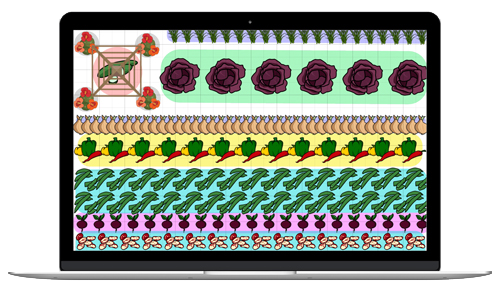
Planting, Growing, and Harvesting Peas
The Almanac Garden Planner - Use It Free for 7 Days!
Plan your 2025 garden with our award-winning Garden Planner.
Types
Shelling Peas: Also known as garden or sweet peas, these are the most common types of peas available. Some good varieties to try include:
- ‘Green Arrow’: 2- to 3-foot vines; no support required; high yields; tolerant of mildew and Fusarium wilt
- ‘Lincoln’: 2- to 3-foot vines; no support required; tolerant of mildew and Fusarium wilt
- The classic ‘Wando’: suitable for freezing
- ‘Thomas Laxton’: high sugar content
- ‘Progress No. 9’: good disease resistance
- ‘Little Marvel’: grows only 15 inches tall
Snap Peas: You eat the entire tender pod of snap peas. Some good varieties to try are:
- ‘Sugar Ann’: vines grow only 2 feet tall, no support required.
- ‘Sugar Snap’: the original (Calvin’s), just brought back; carried only by Johnny’s Selected Seeds
- ‘Early Snap’: an early-maturing version produces peas 10 to 14 days earlier than ‘Sugar Snap’
- ‘Super Sugar Mel’: produces 4-inch-long, very sweet pods
Snow Peas: Common in Chinese cooking, these flat-podded peas have edible pods. Some good varieties to try include:
- ‘Mammoth Melting Sugar’: 4- to 5-foot vines; stringless pods; wilt tolerant
- ‘Oregon Sugar Pod II’: grows only 2-1/2 feet tall
- ‘Snowbird’: resistant to fusarium wilt
Cooking Notes
Ideally, peas should be used when freshly picked as they rapidly toughen and will lose their sweetness.
Green peas can be eaten raw as a snack or in salads. Peas are also excellent in pasta, soups, casseroles, stir-fries, and sautés. Cooking times vary greatly depending on when the green peas were harvested. Young, small ones require less cooking than older, starchy ones.
To steam, put 1 inch of water in a pot, bring to a boil, place a steaming basket in the pan, slowly add peas to the steaming basket, and cover with a lid. Steam for about 2 minutes. Or, to microwave, put 2 tablespoons of water in a microwavable dish and cover. Microwave on high, checking every 2 minutes for doneness. Add butter and salt as desired.
Interestingly, the pea tendrils are also edible! Harvest these young pea shoots when they are 12 to 18 inches out of the ground. As with peas, eat the tender shoots soon after harvesting. Add to salads or into stir-fries at the end of cooking.
ADVERTISEMENT
what month is a good time to plant snap pea and green bean.
Thank you
The best time to plant depends on your location. Go to our planting calendar and enter your location to find the best months for you for snap peas and green beans.
What is best to do with the pea plants after they are finished producing? Do I wait till they turn yellow, or can I pull as soon as the crop is finished? I didn't know if, like soybeans, they add nutrients to the soil simply by growing there. In which case the longer they grow, the more they'd be beneficial to the soil. I noticed that though my plants are now finished bearing (late July) they are actually putting out new growth from the base of the plant. This surprised me and I wanted to know more about the benefits of leaving the plants in the soil. I was planning to use their bed for planting fall(ish) beets.
Hi, Eva, I have every question you asked here too!....When to pull up? Should I leave them? Why the new growth? And one question now to add...did you get an answer? Cheers Annie
Turn over your pea planting beds in the fall, add manure to the soil, and mulch well. As with other legumes, pea roots will fix nitrogen in the soil, making it available for other plants.
Here is a stupid question, I have never planted peas before and I dont know what kind they are. They are long and have a dark color on the tips. We opened one and they looked like a bean. Any suggestions/ideas out there.
I live in western NY. Can I grow snap peas in mid July? I already grew them this spring but would like to get a second crop from them.
Peas like cool temperatures. When sown in the heat of summer, the plants will take longer to mature, and sometimes you won’t get as good a yield. Yet, some gardeners have had success. Check the days to maturity for the variety that you’d like to grow, and add about 1 to 2 weeks to that amount of days; count that amount backward from your first expected fall frost. Choose varieties that are resistant to powdery mildew, as that can be more of a problem with later crops. Keep the plants out of direct blazing summer sun, by providing shade cloth or similar. Add compost and mulch to retain moisture. Good luck!
Help, I planted sugar snap and snow peas together. Now I don't know which is which and I'm afraid to harvest the snaps when they aren't ready or leave the snows on the vine too long. I can't tell them apart. Any suggestions?
If the varieties that you have planted are similar (same color, height, habit), then try bending a pod on each: snap pea pods are crisp and snap when bent, while snow pea pods are more flexible and not easily snapped. The snow pea pod may also be a bit more translucent.













